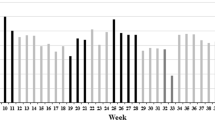Abstract
For nearly 40 years, scientists and elite endurance athletes have been investigating the use of altitude in an effort to enhance exercise performance. While the results of many early studies on the use of altitude training for sea level performance enhancement have produced equivocal results, newer studies using the ‘live high, train low’ altitude training model have demonstrated significant improvements in red cell mass, maximal oxygen uptake, oxygen uptake at ventilatory threshold, and 3000m and 5000m race time. For the marathoner looking to add altitude training to their peak performance plans, residence at an altitude of 2000–2500m, a minimum of 20 hours per day, for 4 weeks, appears to hold the greatest potential for performance enhancement.
Based on published mathematical models of marathon performance, a marathoner with a typical or average running economy who performed ‘live high, train low’ altitude training could experience an improvement of nearly 8.5 minutes (or ≈5%) over the 26.2-mile race distance.
Similar content being viewed by others
References
Adams WC, Bernauer EM, Dill DB, et al. Effects of equivalent sea level and altitude training on V̇O2max and running performance. J Appl Physiol 1975; 39: 262–5
Balke B, Nagle FJ, Daniels JT. Altitude andmaxinurmperformance in work and sports activity. JAMA 1965; 194: 176–9
Dill DB, Adams WC. Maximal oxygen uptake at sea level and at 3090m altitude in high school champion runners. J Appl Physiol 1971; 30: 854–9
Levine BD, Shay-Gundersen J. “Living high-training low”: effect of moderate-altitude acclimatization with low-altitude training on performance. J Appl Physiol 1997; 83: 102–12
Levine BD. Intermittent hypoxic training: fact and fancy. High Alt Med Biel 2002; 3: 177–93
Chapman RF, Shay-Gundersen J, Levine BD. Individual variation in response to altitude training. J Appl Physiol 1998; 85: 1448–56
Joyner MJ. Modeling: optimal marathon performance on the basis of physiological factors. J Appl Physiol 1991; 70: 683–7
Rusko HK, Tikkanen HO, Poltroon JE. Altitude and endurance training. J Sports Sci. 2004; 22: 928–44
Ashenden MJ, Gore CJ, Dobson GP, et al. “live high, tram low” does not change the total haemoglobin mass of male endurance athletes sleeping at a simulated altitude of 3000m for 23 nights. Eur J Appl Physiol Occup Physiol 1999; 80: 479–84
Gore C, Rodriguez FA, Truijens MJ, et al. Increased serum erythropoietin but not red cell production after 4 wk of intermittent hypobaric hypoxia (4000–5500m). J Appl Physiol 2006; 101: 1386–93
Acknowledgements
The authors have indicated that they have no affiliation or financial interest in any organisation(s) that may have a direct interest in the subject matter of this article.
Author information
Authors and Affiliations
Corresponding author
Rights and permissions
About this article
Cite this article
Chapman, R., Levine, B.D. Altitude Training for the Marathon. Sports Med 37, 392–395 (2007). https://doi.org/10.2165/00007256-200737040-00031
Published:
Issue Date:
DOI: https://doi.org/10.2165/00007256-200737040-00031




